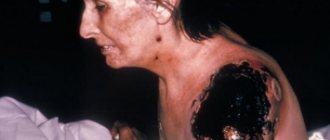The causative agent of smallpox
The provocateur of the development of smallpox is the fact that a virus belonging to the family Poxviridae, subfamily Chordopoxviridae and genus Orthopoxvirus enters the human body. This type of virus is DNA-containing, and its metric parameters are 200-350 nm, and the primary reproduction of the virus occurs in the cytoplasm with the subsequent formation of inclusions.
The antigenic composition of the smallpox virus has similar features to erythrocyte blood cells of group A in human peripheral blood, which explains the weak immune mechanisms, high morbidity and mortality rates in this category of patients.
The smallpox causative agent is characterized by increased resistance to environmental factors, especially to dry air and low temperature. Frozen and lyophilized samples of biological tissue from a patient suffering from smallpox containing the virus can remain infectious for several years to surrounding people and retain vital signs.
The classical etiopathogenetic mechanisms of the development of smallpox consist of a general intoxication syndrome, a pyretic reaction, the formation of pathognomonic elements of enanthema and exanthema, passing through various stages of development, the final link of which is the formation of dense cicatricial intradermal changes.
Smallpox is an exclusively anthroponotic infection and is characterized by a high level of contagiousness, and therefore infectious disease specialists generally classify this disease as a “particularly dangerous infection.” Potential patients for the development of smallpox are all persons in contact with the virus who lack protective immune mechanisms, the development of which is possible after a previous active disease or after vaccination. The maximum incidence rate is observed in Asian and African countries, since in these regions there is often no vaccine against smallpox. The contagious period for smallpox is the time from the last day of the incubation period to the phase of crust rejection. It should be borne in mind that the corpses of patients who died from smallpox continue to be infectious until they are disposed of.
After initial contact with the variola virus through the mucous membrane of the upper respiratory tract or through the skin, the pathogen rapidly moves to the regional lymphatic collectors, after which the onset of a period of viremia occurs. The development of enanthema and exanthema elements is caused by hematogenous infection of the epithelium, where the pathogen actively multiplies. As a result of the weakening of protective immune mechanisms, activation of the secondary flora occurs, which is accompanied by the transformation of the vesicle into a pustule. The process of formation of cicatricial intradermal changes is caused by the death of the germinal layer of the epidermis, deep suppurative and destructive processes. At this stage of development of smallpox, there is a maximum risk of signs of infectious-toxic shock. Severe smallpox in almost 70% of cases occurs with severe hemorrhagic syndrome.
Martial law in Moscow
Kokorekin’s death was the first in a chain of terrible events caused by the disease. On the second day, the disease was discovered in a hospital receptionist who received the artist, a doctor who examined him, and a boy who was on another floor of the hospital, but next to the ventilation hole from Kokorekin’s room. A hospital stoker caught smallpox while simply passing by a room (this best illustrates how viruses can spread).
After some time, the disease was discovered in several more patients at the Moscow Botkin Hospital. Fever, cough and rash are symptoms of the disease, but the speed of spread of the infection is a symptom that said that the country is one step away from an epidemic. The problem was reported to the country's leadership. At a meeting with N.S. Khrushchev adopted a set of measures aimed at preventing an epidemic of smallpox.
The most important task was to identify those who had contact with the sick artist. The scale of the work was enormous. It turned out that in such a short period of time, the infection indirectly affected thousands of people. The risk group includes passengers of the plane from Delhi, pilots, customs officers, colleagues, and relatives of the late Kokorekin. The gifts brought to the mistress and family quickly spread to the thrift stores, so all visitors to the stores were identified and placed in quarantine, and the gifts were destroyed.
The KGB of the USSR, the Ministry of Internal Affairs and the Ministry of Health identified everyone who communicated with the infected. One of those who had contact with the patient was a teacher at a university, where she took exams for students. All students and teachers went into quarantine. The plane on which one of the passengers of that ill-fated flight from India was flying to Paris was promptly deployed.
Botkin Hospital
Source: pinterest.com
In fact, immediately after the New Year celebrations, in the first days of the new year, 1960, Moscow was quarantined under martial law. All roads were blocked. Flights, rail and road transport were cancelled. Medical teams traveled non-stop to addresses, hospitalizing new carriers of the infection. There were 10 thousand people in hospitals, about 1,500 people were primary carriers of the virus. All of them were quarantined in hospitals in Moscow and the Moscow region.
Symptoms and signs of smallpox
The typical classical course of smallpox is accompanied by the development of a relatively short incubation period, ranging from 8 to 12 days. The initial clinical manifestations of smallpox are severe chills, accompanied by febrile fever, intense pain in the lumbar region and lower extremities, severe thirst, dizziness, diffuse pain in the head and vomiting. Due to the absolute non-specificity of these clinical symptoms, it is not possible to establish a diagnosis at an early stage of the development of smallpox, of course, in the absence of an epidemiological history.
The appearance of characteristic pathognomonic signs of smallpox is detected on the third or fourth day of the disease, when at the maximum of fever the appearance of an initial skin rash is noted, occurring as an exanthema in measles. The elements of exanthema in smallpox are localized mainly on the lateral surfaces of the chest in its upper part, as well as in the umbilical, groin areas and on the inner surfaces of the thighs. The elements of the rash are peculiar hemorrhages of the ecchymotic type.
Four days after the onset of clinical symptoms, the temperature reaction normalizes, the signs of intoxication syndrome disappear, which are replaced by typical elements of a rash with a predominant localization on the skin of the back, head and limbs, the development and disappearance of which occurs in stages, from the phase of a hyperemic spot to the formation of scar changes skin. At the same time, similar changes occur in the mucous membranes of the respiratory tract, intestines, genital organs and structures of the urinary system.
A repeated deterioration in the patient's health is observed on the ninth day of the disease, when suppuration of the rash elements is noted and manifestations of toxic encephalopathy in the form of impaired consciousness, hallucinations, psychomotor agitation and increased convulsive readiness are actively increasing. The duration of the period of drying and peeling of the crusts is on average two weeks, after which rough deforming scar changes of the skin are formed.
In persons suffering from immunodeficiency conditions, as well as in children, there are prerequisites for the development of severe forms of smallpox in the form of confluent, pustular-hemorrhagic and smallpox purpura.
In a situation where a person has previously been vaccinated against smallpox, the disease is usually mild and has a long period of incubation of the virus. The clinical picture of smallpox in this situation is limited to moderate malaise, as well as the development of single elements of the rash, the healing of which is not accompanied by the development of cicatricial changes in the skin. The duration of active clinical symptoms in smallpox is 14 days, after which the patient recovers completely. In addition, the atypical clinical course of smallpox may manifest itself in the absence of exanthema or signs of intoxication syndrome.
Among the complications of smallpox, one should first of all take into account the possibility of developing meningoencephalitis, pneumonia, panophthalmitis, keratitis, iritis, and sepsis.
Diagnosis of smallpox
The clinical manifestations present in a patient suffering from smallpox, which are most pronounced at the height of the disease, should be differentiated from the symptoms of other infectious pathologies, and above all with chickenpox. Distinctive signs of chickenpox are the absence of rash elements on the palms and soles, as well as the absence of a clear stage in the development of exanthema. Among the nonspecific laboratory signs of smallpox, changes in the hemogram in the form of leukocytosis with a sharp shift to the left, as well as the detection of myelocytic blood cells in the blood, should be noted.
Specific laboratory diagnosis of smallpox involves the use of virusoscopic, virological and serological research techniques. The contents of pustules are most often used as material for laboratory research, and microscopy of the material using an electron microscope is most effective.
Unfortunately, not every laboratory has highly specialized diagnostic equipment, so the most often used are classical methods for verifying the variola virus, such as light microscopy of a stained smear to detect Paschen-Guarneri bodies, which are oval acidophilic structures located near the nucleus.
As express methods that allow diagnosing smallpox in a short time at the onset of the disease, RNIF methods are used to determine viral antigens in fingerprint smears. In a situation where the discharge of vesicles and pustules is used as a material for research, diagnostic tests such as the immunodiffusion reaction, the complement fixation reaction and enzyme-linked immunosorbent assay should be used.
To isolate the variola virus, the chorion-allantoic membrane of the chick embryo must first be infected, since this is where the virus forms whitish plaques. In addition, human embryonic fibroblasts are also used, with the help of which the cytopathic effects of the pathogen virus in the form of changes in morphology, as well as cell death, are assessed. To carry out differential diagnosis between the variola virus and the causative agent of smallpox in animals, it is necessary to assess the nature of the damage and the maximum optimal temperature for the reproduction of viruses. Identification diagnostic methods for smallpox include the neutralization reaction and RPGA.
Possible complications
Negative consequences after infection and complete recovery from chickenpox can develop only if the patient did not seek medical help in a timely manner, or the patient had a confluent form of this viral disease. In this case, a person may experience the following irreversible processes in the body, namely:
- fulminant sepsis with infectious damage to all tissues of most vital organs and blood;
- inflammation of the cerebral cortex with changes in the cellular structure of the gray matter;
- bilateral granulosa pneumonia of infectious etiology;
- multiple hemorrhages in the subcutaneous layer, which later become the basis for the formation of blood clots;
- damage to the central nervous system, which is expressed in impaired coordination of movements, inadequate response to external stimuli;
- complete loss of vision;
- destruction of the immune system by the destruction of cells that perform a protective function by the virus.
Treatment of smallpox
All patients suffering from smallpox in any clinical form are subject to immediate hospitalization in specialized departments of the infectious diseases hospital for a period of at least forty days from the onset of the disease. In a hospital setting, a sick person must observe long-term bed rest, the duration of which is determined by the duration of the exanthem period, that is, expansion of bed rest becomes possible only after the crusts begin to fall off. A specific diet for smallpox is not used, but to reduce the toxic effect on the liver, the nutritional principles of table No. 4 should be used.
The etiotropic regimen of drug therapy for smallpox involves the use of Metisazone in a daily dosage of 1200 mg, divided into two doses over a course of 6 days, Ribavirin in a daily calculated dose of 200 mg per kg of patient weight for 5 days, Anti-smallpox immunoglobulin 6 ml per day intramuscularly.
In order to prevent the possible development of secondary bacterial complications of smallpox, a short course of antibacterial therapy should be used using semi-synthetic penicillins (Augmentin 0.375 g three times a day orally), macrolides (Azivok 500 mg once a day), cephalosporins (Cefodox 200 mg twice a day).
The following are used as pathogenetic agents for smallpox: multivitamin complexes (Supradin 1 capsule per day), desensitizing agents (Cetrin 1 tablet in the morning), infusion crystalloid solutions (Reopoliglyukin in a volume of 400 ml), short courses of glucocorticosteroids.
Symptomatic therapy is intended to alleviate the patient's condition with smallpox and involves the use of analgesics (Dexalgin in a single dose of 12.5 mg), sleeping pills (Sonapax 50 mg), local treatment of the oral cavity using a 1% sodium bicarbonate solution at least six times a day. day and 0.2 g of Anestezin. The eyes should be wiped with a 15% solution of sodium sulfacyl three times a day, after which the eyelids should be wiped with a 1% solution of Boric acid. Treatment of exanthema elements should be carried out with a 3% solution of potassium permanganate, and during the period of crust formation, which is accompanied by severe skin itching, 1% Menthol ointment should be used.










